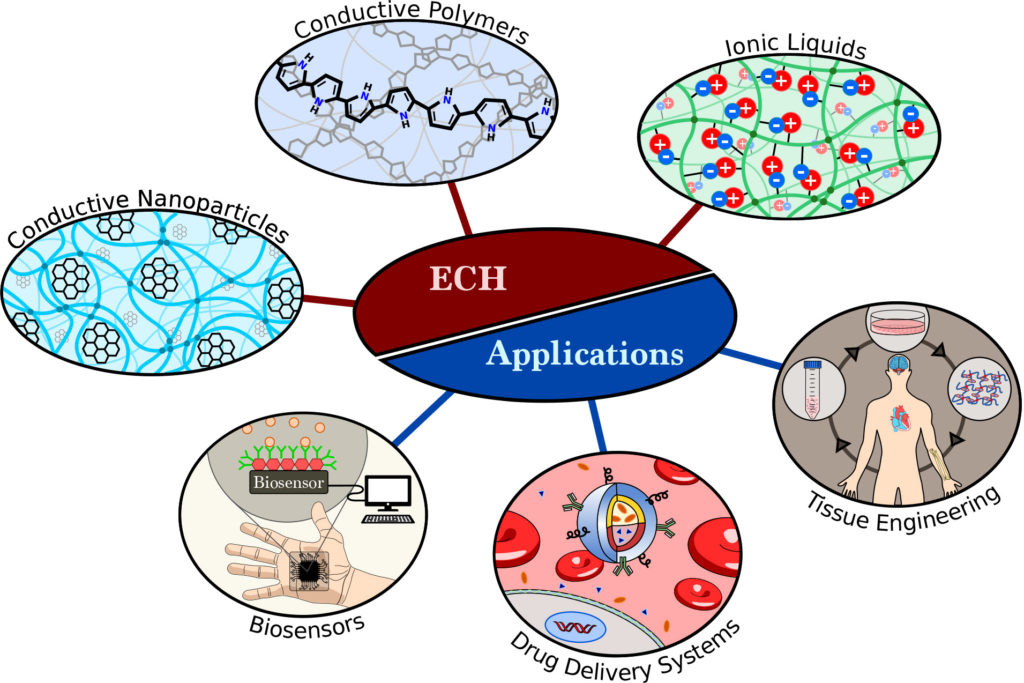Conductive Hydrogels
Electroconductive hydrogels (ECHs) are highly hydrated 3D networks generated through the incorporation of conductive polymers, nanoparticles, and other conductive materials into polymeric hydrogels. ECHs combine several advantageous properties of inherently conductive materials with the highly tunable physical and biochemical properties of hydrogels. Our lab has been focusing on development of highly biocompatible ECHs for different applications such as tissue engineering, drug delivery, and substrate for flexible electronics and other implantable medical devices. We use different methods to form these ECHs, which include: 1) the incorporation of electrically conductive materials such graphene oxide, reduced graphene oxide, and carbon nanotubes into hydrogel network; 2) combining various conductive polymers such as polyaniline, and poly(3,4-ethylenedioxyythiophene) (PEDOT) with different biopolymers; 3) conjugating ionic liquid to the hydrogel networks. These electroconductive composite hydrogels can be used as scaffolds with high swellability, tunable mechanical properties, and the capability to support cell growth both in vitro and in vivo. Furthermore, we combine these ECHs with advanced microfabrication techniques such as three dimensional (3D) bioprinting, micropatterning, and electrospinning to conductive constructs with biomimetic microarchitectures that reproduce the characteristics of the native extracellular matrix (ECM). Our engineered ECHs can be used for various tissue engineering application including cardiac tissue regeneration and nerve repair.

Lab members working in this area: Joyce Huang, Yuting Zheng, Arpita Roy
Related Papers
- Ghovvati, M., Kharaziha, M., Ardehali, R., & Annabi, N. (2022). Recent advances in designing electroconductive biomaterials for cardiac tissue engineering. Advanced Healthcare Materials, 11(13), 2200055.
- Spencer, A. R., Shirzaei Sani, E., Soucy, J. R., Corbet, C. C., Primbetova, A., Koppes, R. A., & Annabi, N. (2019). Bioprinting of a cell-laden conductive hydrogel composite. ACS applied materials & interfaces, 11(34), 30518-30533.
- B. W. Walker, R. Portillo Lara, C. Yu, W. Kimball, and N. Annabi, “Rational Design of Microfabricated Electroconductive Hydrogels for Biomedical Applications”, Progress in Polymer Science, 2019.
- Noshadi, B. W. Walker, R. Portillo-Lara, E. Shirzeai Sani, N. Gomes, M. Reza Azizyan, and N. Annabi, “Engineering biodegradable and biocompatible bio-ionic liquid conjugated hydrogels with tunable conductivity and mechanical properties”, Nature, Scientific Reports, 2017.
- Spencer, A. Primbetova, A. Koppes, R. Koppes, H. Fenniri, and N. Annabi, “Electroconductive gelatin methacryloyl-PEDOT:PSS composite hydrogels: design, synthesis, and properties”, ACS Biomaterials Science & Engineering, 2018.
- N. Annabi, S. Ryon Shin, A. Tamayol, M. Miscuglio, M. Afshar Bakooshli, A. Assmann, P. Mostafalu, J Sun, S. Mithieux, L. Cheung, X. Tang, A. Weiss, A. Khademhosseini, “Highly elastic and conductive human-based protein hybrid hydrogels”, Advanced Materials, 2015.